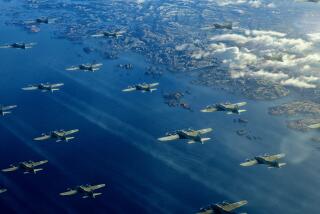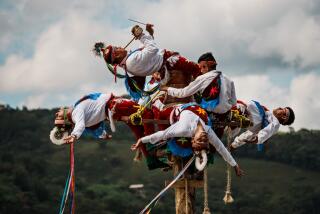Still True-Blue : Butch Voris, Founder of Renowned Flying Team, Aids Local Artist
SAN CLEMENTE — His name probably doesn’t ring a bell. But over the decades, hundreds of thousands of Southern Californians have flocked to the airfields at El Toro and Miramar to see the sensation that he alone created 50 years ago: the Navy’s internationally renowned Blue Angels.
This week, the 76-year-old aviation legend--Capt. R.M. “Butch” Voris--quietly found his way to San Clemente to do a favor for a local artist whom he had never met.
With the 50th anniversary of the exhibition fighter pilots coming up this year, artist Paul Gavin, who was commissioned to do a project on the event, contacted Voris on the off chance that he would lend his expertise to the design.
“This guy is such a human being,” said Gavin, who has created artwork for air shows around the country, including the El Toro Air Show. “I was so taken by the fact that he had an interest in my project and scheduled the whole day here around the studio and the design.”
Voris, who was born and raised in Los Angeles and now lives in Monterey, Calif., was eager to share his experience with the aviation artist.
“It’s a great thrill,” said Voris of the upcoming anniversary. “Never in my broadest imagination would I have thought that the team would have developed into what it has today.”
The Blue Angels have come a long way since 1946, when the tall, young fighter “ace” was handpicked by Adm. Chester Nimitz to put together a special team of naval fighter pilots. The idea was to bring fighter tactics within viewing range of the public, to let them see how World War II was won, Voris said.
Having flown in nearly every major South Pacific air campaign in the war, destroying eight Japanese aircraft along the way, Voris was regarded as a pilot with an impeccable flying record and so was chosen for the job, according to Lt. John Kirby, spokesman for the Blue Angels.
At the age of 26, with only his combat experience to guide him, Voris tackled the job in a matter of months.
“If you think about it, it was an unbelievable task,” Kirby said. “Nobody told him how to do it, how many pilots to use, what maneuvers to choose.”
Assembling a team of four pilots, including himself, Voris decided to use the Navy’s aircraft of choice--the F6F Hellcat, a three-bladed-propeller plane with a top speed of only 380 mph that was used heavily during the final years of the war. The first performance was on June 15, 1946, at the Southeastern Air Exposition in Jacksonville, Fla.
“My only goal at the time was to outdo the Army Air Corps,” Voris said jokingly. “I never thought about it in the long term.”
*
Voris and his team pulled off 17 minutes of blind axis rolls and combat acrobatics that earned them the top prize in the competition.
Later, needing an official name for the team, Voris and his teammates dubbed themselves the Blue Angels, not after celestial air travelers, but after a famous New York nightclub.
But when the Korean War broke out in 1950, the newly formed Blue Angels were disbanded to form the nucleus of a fighter squad. A year later, Voris was again called upon to put together a new team of Blue Angels.
He is the only man in the history of the organization to have commanded the team twice, Kirby said, and one of only two surviving members of the original group. The other veteran, Alfred Taddeo, lives in Southern California.
During his last year as team commander, Voris survived a midair collision during a four-plane diamond formation at an air show in Corpus Christi, Texas. He lived, but one of his team members did not.
“You feel very hurt, but you have to continue,” Voris said. “You’ve got to balance risk with achievement. It’s a compromise of no risk, no gain.”
Voris, who served 23 years in the Navy and later went on to work as a consultant for the National Aeronautics and Space Administration and Grumman Aircraft Engineering Corp., is the last person to brag about his accomplishments.
“He’s truly proud of what he started, but he’s not arrogant about it,” Kirby said. “He’s humble.”
*
Looking back to that first performance in Jacksonville, Voris shook his head in disbelief over how far the Blue Angels have come. Today, Blue Angel pilots reach speeds of up to 1,300 mph--about twice the speed of sound--in their Hornets and put on 70 performances a year.
Now training in El Centro, Calif., the Blue Angels are gearing up for their anniversary year, which includes an appearance at the El Toro Air Show this April, an event Voris hopes to attend.
“You can only have one real objective,” Voris said of life and aviation. “You must pursue perfection.”
More to Read
The biggest entertainment stories
Get our big stories about Hollywood, film, television, music, arts, culture and more right in your inbox as soon as they publish.
You may occasionally receive promotional content from the Los Angeles Times.










